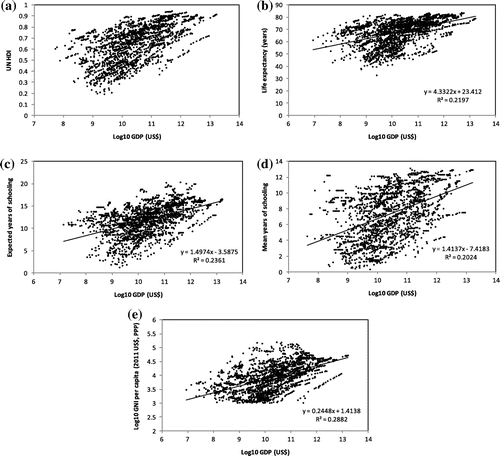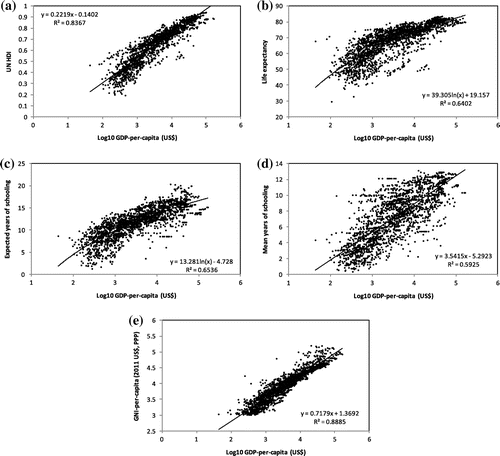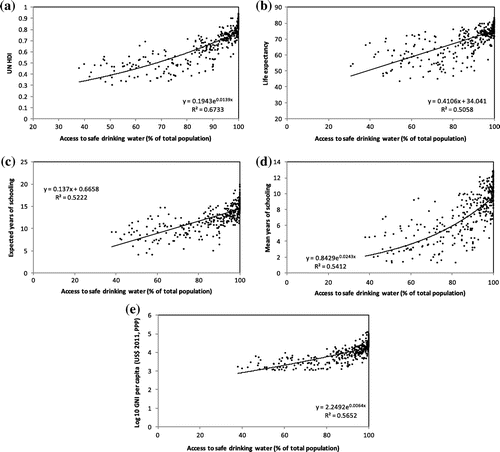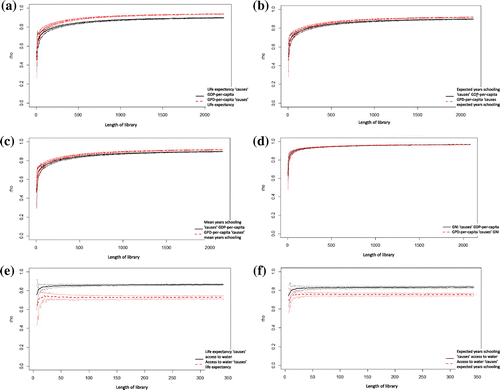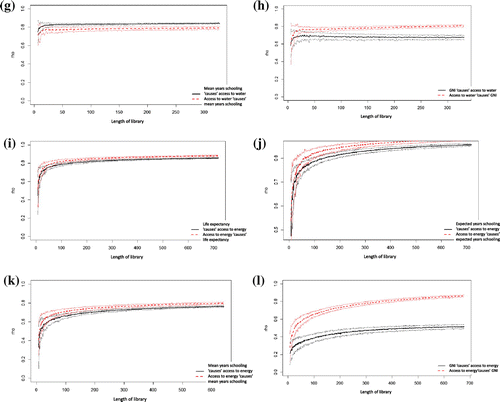Abstract
Human development is increasingly on global policy agendas, in particular related to the Sustainable Development Goals. Here, the UN Human Development Index is analysed for correlation and causation with economic and resource parameters using novel quantitative techniques. Global datasets at national resolution are used to explore correlation and causation with the HDI. The whole HDI is not correlated to national totals of wealth or resource use, but is strongly correlated to personal wealth and resource use. The multi-spatial convergence cross mapping method is adapted to shed light on causation in this system. It is shown that the HDI is tightly linked to the economy and to personal resource use. Analysis of the HDI sub-indices reveals subtleties easily overlooked. For example, it is shown that access to water and electricity strongly influence GNI. It is shown that simple resource accumulation/exploitation is less important in determining HDI growth than personal wealth and access to resources. That is, equitable distribution is more effective than gross accumulation in influencing the HDI. Strong feedback means that investments in water treatment and distribution networks, for example, will have strong effects on HDI change, a conclusion that may play an important role in national developmental policy debate.
1. Global development and the UN Human Development Index
Human and global development have been an important global topic for many years. In 2000, the UN Millennium Development Goals (MDGs), of which there were eight (see http://www.un.org/millenniumgoals), were established, to be completed by 2015. The MDGs did help to raise general awareness of issues targeted by the MDGs; however, there were criticisms, especially surrounding the rationale for the eight targets, as well as the lack of analytical robustness (Deneulin & Shahani, Citation2009). In addition, the MDGs were broad and lacked inter- and intra-country objectives. Progress towards meeting the goals has been very uneven globally. While some targets are met, others such as sanitation and education are not met. More recently, the wider issue of development has received renewed emphasis with the Sustainable Development Goals (SDGs), many of which are directly human development related (see https://sustainabledevelopment.un.org/topics). The SDGs build on the MDGs. There are 17 goals with 169 targets. Despite the widening of scope which addressed some of the earlier ‘cherry picking’ criticism, there are still issues, particularly regarding the operationalisation of the SDGs in practice: that is, how well the proposed indicators actually measure observed phenomena (Hak, Janouškova, & Moldan, Citation2016). While the SDGs seek to measure many aspects of global development sustainability, including environmental sustainability, there is also a large drive towards human development for all nations.
In an attempt to specifically measure human development, many indices have been developed. These include, for example, the Human Poverty Index, the Social Progress Index and the Human Development Index (HDI). Of these, the HDI, which was initially calculated for UN member states in 1975, is arguably the most widely used, being calculated for 182 countries using a consistent framework. The main reason for this wide coverage is that the main measurement variables are simple to understand and easy to measure from national statistics. Despite the widespread usage, the HDI has come under criticism relating to many points, including neglecting inequality and environmental measures, methodological flaws, for failing to portray within-country variability, for the seemingly arbitrary choice of indices and for being overly simplistic and idealised (Hou, Walsh, & Zhang, Citation2015; Ivanova, Citation1994; Sagar & Najam, Citation1998; Stewart, Ranis, & Samman, Citation2006). Despite these criticisms, it still provides a useful yardstick by which to gauge the human development of a country relative to others, even though within-country variability is not accounted for (e.g., intra-country inequity in income, living standards, health, etc., e.g., Adam, Kammas, & Lapatinas, Citation2015; Blum, Citation2013).
The HDI is comprised of four component indices to measure three development dimensions: (1) quality of life; (2) education levels; and (3) standard of living. The component indices to measure these dimensions are life expectancy for (1), expected and mean years of schooling for (2) and GNI-per-capita for (3). Figure outlines the main procedure to calculate the HDI. Details for calculating the HDI are given in UNDP (Citation2014). While the HDI focuses on life expectancy, education and living standards, there are other metrics by which human development may also be measured, as reflected in alternative measurements. Common metrics of interpretation of human development include GDP or GDP-per-capita, level of free speech, democratic rights and electoral processes and various metrics pertaining to water and energy supply and access and sanitation. Many of these are covered in the SDGs.
Figure 1. Schematic to illustrate the steps in calculating the UN HDI. Source: Adapted from UNDP (2014).

Some of these alternative variables are likely correlated to the HDI and may influence it through a causal feedback relationship. For example, increases in GDP may influence certain HDI parameter and/or vice versa. At present, however, it is unclear how, or if, the HDI and its dimension indices (Figure ) are correlated to other measurement variables, with previous studies being largely inconclusive or restricted to narrow study scopes (Metha, Citation2014; Ouedraogo, Citation2013; Ranis et al., Citation2000), although some correlations are clear. For example, the link between life expectancy and access to safe drinking water has been demonstrated (Green, Citation2001; Metha, Citation2014). Through access to safe, clean water, the transmission of waterborne disease is greatly reduced, improving overall health and leading to increased life expectancy. What is less clear is the causation between the HDI and other measures.
Correlation can be explained as a demonstrable relationship between two variables. Such relationships can have variable strength. In principle, any two variables could be correlated (e.g., person height and nutritional intake (Grasgruber, Cacek, Kalina, & Sebera, Citation2014; Grasgruber, Sebera, Hrazdira, Cacek, & Kalina, Citation2016)); atmospheric CO2 concentrations and global average surface temperatures (IPCC, Citation2014). However, simple correlation between variables does not imply underlying causality. That is, just because two variables are correlated, it does not necessarily follow that changes in variable ‘A’ are responsible for changes in variable ‘B’, or vice versa. Unravelling causality between variables is much more complex. While some links between economic and resource variable and human development are well understood in terms of causal relationships (e.g., clean water access and the implications for human health), others studied here are very poorly understood. While correlation may be demonstrated, understanding causal relationships is lacking. Better understanding of underlying causality could lead to shifts in long-term policy planning, with more focus on development aspects within a country that would specifically target those economic/resource issues that could bring about a human development benefit This would represent more efficient or ‘optimised’ policy approaches.
In this work, both correlation and causation are explored between the HDI (and the dimension indices) and national economic, water and energy variables. This study examines globally consistent timeseries’ on the HDI, economic metrics and water and electricity metrics in order to firstly assess whether or not variables are correlated and, if they are, to understand whether or not there is underlying causality and, if so, how strong and in which direction. Through a better understanding of correlation and quantitatively-assessed causality, more robust, scientifically-based policy decisions can be made. As an example, if it can be demonstrated that change in a certain parameter (e.g. GDP) has a robust positive influence on the overall human development of a nation, then policy can be adapted to target actions that drive GDP growth in order to affect change in the HDI. If bi-directional causality is demonstrated, then such a change described would be likely to feedback and result in a change in GDP. We hypothesise that changes in economic and resource conditions can affect changes in human development and these changes can be quantified through robust causal analysis. This study adds to this literature using a method novel to this field and represents a novel additional tool for policymakers that can be used for robust decision-making.
This study offers new information and insight on correlation and causality between the HDI and its dimension indices and economic, water and energy metrics, which may also be used as a measure of development. A methods and data section describing the analysis is followed by presentation of the results, discussion and implications for nation human development improvement.
2. Data and methods
For the analysis in this paper, extensive, globally consistent, open-source data were used. The UN HDI data were obtained from the UN HDI portal (http://hdr.undp.org/en/content/human-development-index-hdi; last accessed August 2015). The national GDP data were obtained from The World Bank (http://data.worldbank.org; last accessed August 2014), while the GDP-per-capita data were obtained from the UN Data portal (http://data.un.org; last accessed August 2014). All water-related data were downloaded from the FAO AQUASTAT database (http://www.fao.org/nr/water/aquastat/main/index.stm; last accessed August 2014, except access to safe drinking water, last accessed August 2015). Energy generation and consumption data were obtained from the US Energy Information Administration (www.eia.gov; last accessed October 2014). The access to electricity data were taken from The World Bank (http://data.worldbank.org; last accessed September 2015). All primary data used in this study is at national spatial resolution. The temporal resolution is variable, depending on the data. The UN HDI is reported for 1980, 1985, 1990 and 2000 and then annually from 2005–2013. The GDP and GDP-per-capita data are reported annually from 1980, as are the energy data. The water data are reported at 5-year reporting intervals, although the reporting year within each 5-year interval is not consistent between nations. The minimum number of nations analysed was 173 and the maximum was 193, depending on which comparison was being performed. Table outlines the data used, along with statistics regarding these data. While each of these datasets has their own downsides, they are openly available, globally consistent, well reported and commonly used. Thus, they provide a consistent foundation for the analysis in this study.
Table 1. Summarising the data used for this study, including basic data statistics and sources. See text for further details.
Regarding the variable in Table , over the past 30 years, the general trend has been one of increase. For example, GDP (total and per-capita) has generally increased globally since the early 1980s, although GDP-per-capita growth has stalled over the past few years due to the global recession. Likewise, and in part due to the Millennium Development Goals (MDGs) and succeeding Sustainable Development Goals (SDGs), access to water and electricity have increased over the last 30–35 years, as have water and electricity consumption and generation. How these growths are correlated and what the causal relation between these growths are is unclear and is the focus of this paper. As a specific example, taking access to safe drinking water (as a percentage of the national population) which was first reported in 2007 and again in 2012, almost all nations show either no change (especially in those cases with 100% coverage in 2007) or an improvement in coverage. Unfortunately, some countries show a slight decrease in this time period and, also, some countries with relatively low coverage show only marginal improvement. Likewise, for energy consumption, reported annually from 1980, there has been growth since 1980, in some cases of considerable multiples, although there has been a noticeable slowdown in growth over the past 4–5 years.
For the correlation analysis in this study, the HDI and HDI dimension indices were treated as dependent variables, with the economic, water and energy variables (Table ) being the independent variables. This part of the work consists of global-scale national-level analysis of the UN HDI (and the dimension indices) and economic, water and energy data to identify potential correlations between human development indices and economic prosperity (national and personal), water withdrawals and access to safe drinking water and national-level energy generation and consumption and access to electricity. The following set of correlations were performed: HDI and HDI dimension indices (of which there are four, Figure ) against (i) national GDP; (ii) per-capita GDP; (iii) national freshwater withdrawals; (iv) per-capita freshwater withdrawals; (v) access to a safe drinking water supply; (vi) national net electricity generation; (vii) national net electricity consumption; and (viii) access to an electricity supply. Therefore, 40 correlations were performed in total.
The general correlation analysis process can be described in the following four main steps:
| (1) | Match country names between independent and dependent variable datasets. Variations on names were accounted for (e.g., United States and United States of America). Exclude non-matches. Exclusion represents a small number of the total countries (usually ~ 10–15 countries). | ||||
| (2) | For the dependent and independent sets, data were rationalised in order to make them directly comparable, country-by-country, year-by-year. Null/empty data were treated as a blank (blank data were filtered out in Step 3). | ||||
| (3) | The rationalised data from Step 2 were processed to include only instances where there was an entry for a given country and a given year in both the independent and dependent sets. ‘Complete entries’ were selected and transformed using log10 if necessary (e.g. for the energy data). | ||||
| (4) | Plot the rationalised ‘complete data’ to determine correlation. | ||||
For the causality part of the work, the recently developed convergence cross-mapping (CCM) method of Sugihara et al. (Citation2012) was considered. Briefly, CCM tests for causation by measuring the extent to which historical values of Y can reliably estimate states of X, something that happens only if X causally influences Y. CCM does this by looking for a ‘signature’ of X in Y’s time series by determining if there is correspondence between a ‘library’ of points in the attractor manifold built from Y and points in the X manifold. These manifolds are built from lagged coordinates of the X and Y time series values. If the time indices of nearby points on the Y manifold can identify points on the nearby X manifold then Y can be used to estimate X (and vice versa). Full details of the CCM method and complete algorithmic description are presented in Sugihara et al. (Citation2012). One potential issue with the classic CCM method is regarding the minimum length of the time-series. It is suggested that CCM should be used in cases where data length is > 30. Unfortunately, many of the variables used for this study have fewer than 30 measurements and, therefore, CCM is not applicable in its standard form. CCM was adapted by Clark et al. (Citation2015) in order to piece together multiple replicate observations from spatially distributed plots with short time-series. This adapted method, multi-spatial CCM, was originally developed for ecological analysis and its use here with respect to analysis of the HDI is novel and circumvents the requirement of a time-series of at least 30 measurements. Multi-spatial CCM essentially ‘patches’ together equivalent data from many replicate observational plots which may be spatially distributed to yield a single longer dataset under the assumption that the underlying dynamics between plots are equivalent. Bootstrap statistical techniques are exploited to allow for the generation of lengthy representative time-series’ from many much shorter datasets. Indeed, this method has been shown to work with as few as five data points in any single plot (Clark et al., Citation2015). When using multi-spatial CCM it is assumed that the underlying dynamics between system variables is the same between plots, an assumption that is made for this study. A full description of multi-spatial CCM is given in Clark et al. (Citation2015), but it proceeds in five main steps: (1) determine the best embedding dimension, E, for analysis; (2) test for non-linearity and noise; (3) calculate two processes’ abilities to describe each others’ dynamics; (4) use bootstrapping to leverage spatial information; and (5) test whether predictions indicate a significant causal relationship.
In this study the ‘plots’ are the countries reporting HDI and metric data and the ‘observations’ are the reported HDI and metric values. For this analysis, the code given in Clark et al. (Citation2015) and freely available as a package in the R programming language (R Core Development Team, Citation2014) was adapted for this study. The E dimensionality value (Clark et al., Citation2015; Sugihara et al., Citation2012) was determined individually for each simulation, and was always > 2. Each computation comprises 100 bootstrapped simulations to ensure consistent and robust results.
3. Correlating the UN HDI to economic wealth, water and energy use
Using the extensive, globally consistent, open-source data (see Data and Methods) the UN HDI and each of its four dimension indices were correlated to national GDP (hereafter GDP), GDP-per-capita, per-capita water withdrawals, total national water withdrawals, access to safe drinking water, net annual electricity generation and consumption and access to electricity supply. A total of 40 correlations were carried out.
3.1. HDI correlated to GDP and GDP-per-capita
It is shown that the HDI and all dimension indices are very weakly correlated to GDP (Figure ). All r2 values are c. 0.25, with a maximum of 0.28. While it could be argued that a vague trend is observed, there is so much scatter that this trend is very weak. However, HDI and the dimension indices are strongly correlated with GDP-per-capita (Figure ). Unsurprisingly, GDP-per-capita is very strongly correlated to GNI-per-capita (r2 = 0.89; Figure e), but GDP-per-capita is also strongly correlated to life expectancy (r2 = 0.64), the expected and mean years of schooling (r2 = 0.65 and 0.59, respectively) and the composite HDI index (r2 = 0.84). This has the implication that personal wealth is more important for human development than total national wealth, something that will be returned to in the Discussion section.
3.2. HDI correlated to water variables
When the HDI and the dimension indices are plotted with total national water withdrawals, no evidence of any relationship is identified. In all cases, the plots show a point cloud of data with no apparent structure. Likewise, when per-capita water withdrawal is compared, no evidence of any relationship is identified. In this paper, withdrawal is taken to mean the gross volume of water extracted from the supply and does not represent the volume actually used (consumed). Consumed water can be a considerably lower volume than that withdrawn, as many processes (e.g., power station cooling) return water back to the environment, albeit usually at lower quality. When access to safe drinking water (as a percentage of the total population) is considered, strong correlations were identified (Figure ). This variable is most strongly correlated to the HDI (r2 = 0.67) followed by the correlation with GNI-per-capita and is most weakly correlated to life expectancy (r2 = 0.51, Figure e).
3.3. HDI correlated to electricity variables
With regard to total net annual electricity generation and consumption, the correlations are very weak, with r2 values around 0.3. For both generation and consumption that pattern is similar, mainly because, for most countries, consumption approximates generation, except in cases with a significant import/export of power. As was the case for the water variables, the situation is very different when access to electricity is taken into account. Strong correlations are evident with all the HDI metrics. HDI is very strongly correlated with access to electricity, with r2 = 0.76 (Figure ), followed by life expectancy, GNI-per-capita and the mean and expected years of schooling, with r2 = 0.7, 0.61, 0.56 and 0.55, respectively.
Figure 5. Correlations between access to electricity and (a) the HDI, n = 643; (b) life expectancy, n = 407; (c) expected years of schooling, n = 697; (d) mean years of schooling, n = 647; and (e) GNI-per-capita, n = 682. Source: Authors.
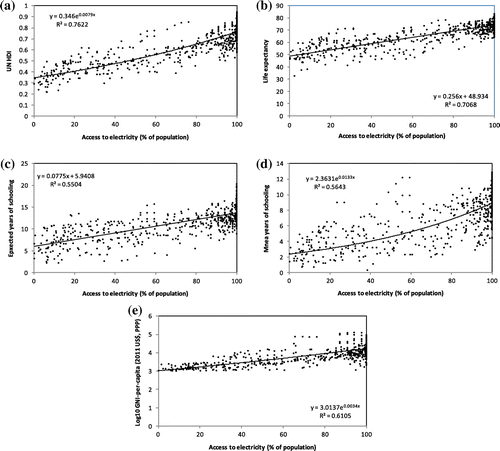
These results strongly suggest that personal wealth and high levels of access to resources across the population appear more important in determining human development more than national totals. The implication is that equitable distribution of wealth and services through a population will do more to increase human development nationally than merely increasing national GDP or total resource use/extraction rates. While these correlations are in themselves interesting, little is gained regarding the causality in these relationships. We address this in the next section.
4. Where lies the causality?
In an attempt to shed light potential causality between the HDI and the economic, water and energy metrics, the multi-spatial convergence cross-mapping (multi-spatial CCM) methodology was used (see Data and Methods Section and Clark et al., Citation2015). In this present analysis, the countries are analogous to spatially distributed sample plot replicates, with each ‘plot’ having between two (for access to safe drinking water) and 11 (for GDP-per-capita) ‘observations’ between variables. There are up to 193 ‘plots’, depending on the comparison being undertaken. The causality analysis is performed only for strongly correlated variables (i.e., HDI compared to GDP-per-capita and access to water and electricity). Both the whole HDI index and the constituent sub-indices were tested.
4.1. Causality with the HDI
Results suggest that, for all three pairings (HDI with GDP-per-capita and access to safe drinking water and electricity supply), strong bi-directional causation (feedback) is apparent (Figure ). When reading Figure , a rho value much greater than zero that is stable after the initial rise implies causation. A very rapid rise to stability can imply synchrony (Sugihara et al., Citation2012). This is discussed in the next section.
Figure 6. Multi-spatial CCM results to discern causality between: (a) HDI and GDP-per-capita; (b) HDI and access to safe drinking water; and (c) HDI and access to electricity. Solid lines show the mean of the simulations. Dashed lines indicate standard deviation. Stable values of rho significantly >0 imply causation. Source: Authors.
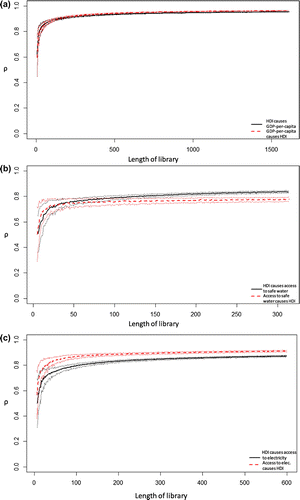
The HDI and GDP-per-capita display almost equal levels of causation (Figure a). This suggests that they are tightly connected, with changes in one having a great impact on the value of the other. This tight connection is explored in the Discussion section. HDI is shown to have a marginally greater causal influence on access to safe drinking water. The implication is that HDI influences access to safe drinking water throughout a population slightly more than vice versa, although the difference in causation is not great. Conversely, access to an electricity supply is suggested to have a marginally greater causal influence on HDI than vice versa.
4.2. Causality with the HDI sub-indices
When causality was assessed for each sub-index of the HDI (Figure ), the results show interesting patterns and hint at subtleties in determination of the HDI that can be overlooked when considering the HDI as a whole. All the sub-indices when analysed against GDP-per-capita show tight causal coupling in both directions, as for the whole HDI (Figures a–d). When the sub-indices are analysed against access to water (Figures e–h) there are some differences in apparent causal direction. While expected and mean years of schooling show very little difference, life expectancy and GNI show interesting results. There is apparently greater causal influence of life expectancy on access to water than vice versa, while GNI is shown to cause access to water supply. When the sub-indices are analysed against access to energy (Figures i–l), the results are also interesting. While life expectancy and expected and mean years of schooling show close coupling, it is strongly suggested that GNI causes access to electricity supply. These results are discussed further in the next section.
Figure 7. Multi-spatial convergence cross mapping for (a) life expectancy and GDP-per-capita; (b) expected years of schooling and GDP-per-capita; (c) mean years of schooling and GDP-per-capita; (d) GNI and GDP-per-capita; (e) life expectancy and access to water; (f) expected years of schooling and access to water; (g) mean years of schooling and access to water; (h) GNI and access to water; (i) life expectancy and access to electricity; (j) expected years of schooling and access to electricity; (k) mean years of schooling and access to electricity; and (l) GNI and access to electricity. Source: Authors.
5. Discussion
The results of the research suggest that determining exactly what drives the whole HDI, and in which direction the dominant causality lies (e.g., does HDI drive economic and resource variables or the other way round), is unclear. However, together with the correlation results, this work makes it clear that equitable distribution of wealth and services throughout a population has a greater impact on HDI improvements than simply accumulating absolute levels of wealth or extracting greater levels of natural resources, and that the HDI and economic, water, and energy metrics are very closely intertwined in complex feedback relationships. These relationships may be impossible to completely unravel. Not only are the differences in causal direction marginal (see Figure ), but the very rapid rise to equilibrium (especially for the HDI - GDP-per-capita plot, Figure a) hints at the phenomenon of synchrony (Sugihara et al., Citation2012). Synchrony implies that the forcing from one process is so strong that the second process is subordinate to it, making determination of causation very difficult. Because of the very short time series used in this analysis, looking for unambiguous preceding dynamic effects (cf. van Nes et al., Citation2015) cannot be exploited. While these results suggest strong causal relationships with probable feedback at play, they also serve to reinforce the point that determining causality in such a complex system is very difficult, and could be impossible to completely analyse.
Results analysing causality with the HDI sub-indices hint at more subtle relationships that are hidden when only the whole HDI is accounted for. For these sub-index analyses, only the highly correlated variables of GDP-per-capita, access to water, and access to electricity were considered. All sub-indices when analysed for causality with GDP-per-capita showed very similar results, suggesting tight bi-directional coupling between these variables. As with the entire HDI, it is, therefore, hard if not impossible to determine whether or not there is a dominant driving factor. When access to water was analysed with the HDI sub-indices, the results are somewhat surprising. Results suggest that it is life expectancy that marginally dominates as the driver, causing changes in access to water, when it would be expected to be the other way round (Cutler, Deaton, & Lleras-Muney, Citation2006; Green, Citation2001; Marmot, Citation2012). It is suggested that this result is erroneous and does not reflect the real situation, especially in regard to previous studies (see further discussion below). However, it is shown that access to water drives changes in per-capita GNI, as would be expected. As access to clean water increases, the population overall is healthier, enabling greater participation in education and employment, which in turn will contribute to an increase in personal GNI. Regarding the analysis of causality for access to an electricity supply, results also show subtleties missed when the whole HDI is considered, especially regarding causality with the GNI. It is shown (Figure l) that access to electricity strongly causes a change in the GNI. This can be explained in a similar way to access to water. By having access to electricity, the working and/or studying day can be lengthened, and previously arduous manual tasks can be made greatly more efficient through the use of electric motors (e.g., gathering water from a deep well). This can lead to enhanced education and employment opportunities, which in turn raise personal GNI.
The weak correlation of total GDP to HDI may be due to how different nations redistribute wealth, to which sectors, and how effective this spending is once it is allocated to the sectors (Culter et al., Citation2006). This result suggests that simple national wealth accumulation is generally ineffective in raising overall living standards, reflected by the HDI. GDP-per-capita is shown to be very strongly correlated with the HDI. Personal wealth, unlike national wealth, can be directly leveraged to procure, for example, better levels of schooling, either through private education, via relocation to areas with better schools, or through additional extracurricular activities and tutoring. It can be used to purchase better healthcare options and it has been suggested (Cutler et al., Citation2006; Marmot, Citation2012) that those with greater personal wealth (or generally equivalently of a higher socioeconomic standing) tend to live longer. This link between personal wealth and life expectancy is particularly apparent in the HDI at the higher personal wealth values (log10[GDP-per-capita] > 4, Figure b, indicated by a lower degree of scatter around the trend), backing up these previous claims. However, reflecting the tight bi-directional causality implied by the multi-spatial CCM analysis (Figures a and a–d), the opposite may also be stated: better levels of education and prolonged periods of good health may lead to more time in higher paid jobs, increasing both national and personal income (Case & Deaton, Citation2003; Hurt, Ronsmans, & Saha, Citation2004), thus helping to drive up the HDI. The dominant causality is unclear, agreeing with the findings of Cutler et al. (Citation2006). It has also been suggested that greater levels of equality, particularly wealth equality, lead to greater overall levels of welfare in a population (Blum, Citation2013). Ravallion (Citation2014) concludes that inequality within a population can stall growth prospects in a country, backing up our suggestion of equitable distribution of wealth and resources to promote human development. The strong correlation with GNI-per-capita is not surprising, as one expects personal income to rise with productivity, and there is indeed a two-way loop at play, described in detail by Ranis, Stewart, and Ramirez (Citation2000). A counter argument is that a given nation could be very adept at converting services such as healthcare and schooling into economic growth through a very structured social progression profile, which would subsequently reflected in GDP-per-capita reporting, further complicating the analysis regarding the chain of causation.
With regard to water, results show that simply obtaining large volumes of water nationally and/or subsequently supplying ample water resources to the population (reflected in per-capita withdrawal statistics) does not have any correlation with the HDI or the dimension indices. More important for HDI growth is the widespread distribution of this resource throughout a population, such that high proportions of a country have access to a safe water supply. This means investing in water treatment and distribution infrastructure. Such distribution is indicated to have a strong bearing on life expectancy and the HDI. Access to clean water has been shown (Cutler et al., Citation2006; Green, Citation2001; Marmot, Citation2012) to improve life expectancy, due to reduced exposure to water-borne disease and the role of water in sanitation and sanitation systems. Access to a safe drinking water supply, through its central role in improving health, is also likely to lead to increased years in schooling and employment (reflected on GDP and GNI statistics). As overall population health improves, as education levels rise and as the industrial, technical, scientific and socio-political capabilities of a nation develop, the infrastructure to deliver safe drinking water and the ability to develop and finance this infrastructure gradually increases. Therefore, there is a strong feedback between HDI and water access, reflected in both the whole HDI and in the sub-indices, particularly with regard to GNI, where it is shown that access to water drives GNI (discussed above).
The HDI and the dimension indices are not strongly correlated with national total energy statistics—either electricity generation or consumption. As with national water withdrawals, national energy generation and usage will largely depend on differing industries (which have greatly different electricity demand, not all of which is of direct benefit to a population or an individual), power use efficiencies and energy export priorities, for example. As with water, simply generating or consuming more electricity does not imply significant improvement in HDI for the reasons just given—this electricity may be generated for nor used by individuals, but either by industry or for export. High personal levels of access to an electricity supply is strong correlated to the HDI and the dimension indices, in particular to the GNI sub-index. The multi-spatial CCM analysis (Figures and i–l) suggests that increasing access to electricity can help drive the HDI upwards, that is, to improve living and development standards. Previous work has demonstrated that the electricity consumption rate (measured in kW/capita) is strongly correlated to some of the HDI-variables explored here; however, the level of access to electricity was not considered as an independent variable (Pasten & Santamarina, Citation2012). Again, the causal chain is not explicit, with tight feedback between the two very likely in operation. Although this work implies that access to electricity causes change in the HDI (for example by offering the opportunity for longer hours for self-study and education, entertainment, employment and by allowing considerable time and manpower savings in laborious tasks), the fundamental causal link between the elements is non-trivial to unravel, although this analysis makes important first steps by showing that access to electricity is an important driver when it comes to personal GNI.
Despite the non-trivial nature of the causal relationships between the HDI and economic, water and energy variables, this work has important implications for national development policy, especially related to human development and how to accelerate it. It is strongly suggested that national investment and policy should be targeted such that personal wealth and access to resources are maximised, and that national accumulations of wealth and resources are efficiently and equitably spread throughout a population in order to improve national welfare and to accelerate national growth (Blum, Citation2013; Ravallion, Citation2014). Electricity and freshwater treatment and distribution networks should be heavily invested in. This work demonstrates that, although these investments may be costly in the short-term, such investment would likely be rapidly repaid into the economy due to the strong feedbacks highlighted in this work. For example, by investing in the infrastructure to allow people to study and work for longer and to live healthier lives, people may spend longer in work and have higher skilled jobs that bring more money back to the economy, which in turn will allow greater HDI growth and so on. The message is clear: simply procuring more power, water or wealth does not imply an increase in human wellbeing or development. These resources need to be made safely available throughout a population, with improvements in health, education and standards of living following.
Policy that focuses on personal wealth improvement and equitable distribution of wealth, access to safe drinking water and electricity are key to improving overall national human development and that national resources and finance should be prioritised on these areas if improvements to human development are to be taken seriously. This work also fits well with the recently agreed SDGs and offers an effective way to meeting many of them by exploiting tight feedback relationships. In fact, equality is one of the SDGs—a globally accepted set of targets for all nations to strive towards. As greater levels of equality and equity are built into the SDGs, there is already potential for knock-on impacts on other development indicators, as suggested by the causal relationships identified in this study. Similarly, the OECD (Citation2014) show that, at the EU-level, equity and access to resources promoted as a way to also promote more general development gains. Promoting access to resources as a way to promote economic and human development is being increasingly recognised and built into development policy. Even though the precise nature of these causal relationships is unclear, they are demonstrated in this study to be important, and by focusing the economy, water and electricity on these, it is likely that human wellbeing will improve. The chain of causality will subsequently take effect, leading to improvements in the HDI component indices and, therefore, the HDI, with corresponding knock-on effects throughout the economy.
6. Conclusions
Global development, human development, and how to accelerate both have been important policy questions for some time, receiving particular attention with the adoption of the Millennium Development Goals and, more recently, the Sustainable Development Goals, many of which are human development related. While some studies investigate certain relationships of the HDI with the economy for example, these have been very narrow in scope, focusing only on a few limited variables, and tend to focus only on the whole HDI. This work uses global scale, national-resolution datasets to investigate correlation and causality between the HDI and, for the first time, the HDI sub-indices and economic, water and energy metrics, providing a more detailed and coherent analysis than previously undertaken.
Through comprehensive analysis of these datasets, we show that national totals of GDP, water withdrawal and electricity generation and consumption, along with per-capita water withdrawal, are not strongly correlated to the HDI and its dimension indices. However, per-capita GDP and access to safe water and an electricity supply are strongly correlated to the HDI. This implies that simple national accumulation of wealth and resources are less important to human development than equitable distribution of this wealth and resources through a population. In this way, these resources can be directly leveraged by individuals for personal betterment.
Multi-spatial convergence cross mapping was used to determine if there is possible causation between the HDI and per-capita GDP and access to water and electricity and, if so, to try to determine if there is a dominant causal direction. This work demonstrated that causality is apparent in both directions between the HDI and all three variables, suggesting that strong feedback is at play and can be exploited in policy decisions. When the HDI sub-indices were considered, subtleties were brought to light that are lost when considering the whole HDI. Of particular interest are the results that show access to water and electricity are key drivers of personal GNI. More generally, however, the direction of causality is not easily determined, demonstrating the complexity inherent in such socio-ecological-political systems. The results do suggest, however, that, if a nation does commit policy and resources to improving personal-level wealth and access to resources through investing in water treatment and distribution systems for example, this investment will be rapidly manifested in HDI growth, which in turn will lead to economic and resource gains due to the complex chain of feedback at play.
It is hoped that the message from this work of investment in equitable distribution of resources for concerted HDI growth may make an impact on nation-level development priorities.
Disclosure statement
No potential conflict of interest was reported by the authors.
References
- Adam, A., Kammas, P., & Lapatinas, A. (2015). Income inequality and the tax structure: Evidence from developed and developing countries. Journal of Comparative Economics., 43(1), 138–154. doi:10.1016/j.jce.2014.05.006
- Blum, M. (2013). The influence of inequality on the standard of living: Worldwide anthropometric evidence from the 19th and 20th centuries. Economics and Human Biology, 11(4), 436–452. doi:10.1016/j.ehb.2012.12.002
- Case, A., & Deaton, A. (2003). Broken down by age and sex: How our health declines ( NBER Working Paper No. 9821). Cambridge, MA: National Bureau of Economic Research.
- Clark, A. T., Ye, H., Isbell, F., Deyle, E. R., Cowles, J., Tilman, G. D., & Sugihara, G. (2015). Spatial convergent cross mapping to detect causal relationships from short time series. Ecology, 96(5), 1174–1181.10.1890/14-1479.1
- Cutler, D. M., Deaton, A. S., & Lleras-Muney, A. (2006). The determinants of mortality ( NBER Working Paper No. 11963). Cambridge, MA, USA. Retrieved from http://www.nber.org/papers/w1196310.3386/w11963
- Deneulin, S., & Shahani, L. (2009). An introduction to the human development and capability approach freedom and agency. Sterling, Virginia Ottawa, Ontario: Earthscan International Development Research Centre. ISBN 9781844078066.
- Grasgruber, P., Cacek, J., Kalina, T., & Sebera, M. (2014). The role of nutrition and genetics as key determinants of the positive height trend. Economics & Human Biology, 15, 81–100. doi:10.1016/j.ehb.2014.07.002
- Grasgruber, P., Sebera, M., Hrazdira, E., Cacek, J., & Kalina, T. (2016). Major correlates of male height: A study of 105 countries. Economics & Human Biology, 21, 172–195. doi:10.1016/j.ehb.2016.01.005
- Green, V. W. (2001). Personal hygiene and life expectancy improvements since 1850: Historic and epidemiologic associations. American Journal of Infection and Control, 29, 203–206. doi:10.1067/mic.2001.115686
- Hak, T., Janouškova, S., & Moldan, B. (2016). Sustainable development goals: A need for relevant indicators. Ecological Indicators, 60, 565–573. doi:10.1016/j.ecolind.2015.08.003
- Hou, J., Walsh, P. P., & Zhang, J. (2015). The dynamics of human development index. The Social Science Journal, 52, 331–347. doi:10.1016/j.soscij.2014.07.003
- Hurt, L. S., Ronsmans, C., & Saha, S. (2004). Effects of education and other socioeconomic factors on middle age mortality in rural Bangladesh. Journal of Epidemiology and Community Health, 58, 315–320.10.1136/jech.2003.007351
- IPCC. (2014). Climate change 2014. Synthesis report summary for policy makers. 32pp. Retrieved from www.ipcc.ch
- Ivanova, I. S. J. (1994). Effects of the human development index’s social and economic components on country rankings. New Brunswick, Canada: University of New Brunswick. Mimeographed.
- Marmot, M. (2012). Social determinant of health inequality. Lancet, 365, 1099–1104.
- Metha, L. (2014). Water and human development. World Development, 59, 59–69. doi:10.1016/j.worlddev.2013.12.018
- OECD. (2014). Better policies for development 2014: Policy coherence and illicit financial flows. Paris: OECD Publishing. doi:10.1787/9789264210325-en
- Ouedraogo, N. S. (2013). Energy consumption and human development: Evidence from a panel cointegration and error correction model. Energy, 63, 28–41. doi:10.1016/j.energy.2013.09.067
- Pasten, C., & Santamarina, J. C. (2012). Energy and quality of life. Energy Policy, 49, 468–476. doi:10.1016/j.enpol.2012.06.051
- R Core Development Team. (2014). R: A language and environment for statistical computing. Vienna, Austria: R Foundation for Statistical Computing. Retrieved from www.r-project.org
- Ranis, G., Stewart, F., & Ramirez, A. (2000). Economic growth and human development. World Development, 28(2), 197–219.10.1016/S0305-750X(99)00131-X
- Ravallion, M. (2014). Income inequality in the developing world. Science, 344, 851–855. doi:10.1126/science.1251868
- Sagar, A. D., & Najam, A. (1998). The human development index: A critical review. Ecological Economics, 25, 249–264.10.1016/S0921-8009(97)00168-7
- Stewart, F., Ranis, G,, & Samman, E. 2006. Human development: Beyond the HDI ( QEH Working Papers qehwps135). Queen Elizabeth House. University of Oxford.
- Sugihara, G., May, R., Ye, H., C-h, Hsieh, Deyle, E., & Fogarty, Munch S. (2012). Detecting causality in complex ecosystems. Science, 338, 496–500. doi:10.1126/science.1227079
- UNDP. 2014. Human Development Report 2014 Technical Notes, 10pp. Retrieved from http://hdr.undp.org/en/2014-report/download
- van Nes, E. H., Scheffer, M., Brovkin, V., Lenton, T. M., Ye, H., Deyle, E., & Sugihara, G. (2015). Causal feedbacks in climate change. Nature Climate Change, 5, 445–448. doi:10.1038/nclimate2568

